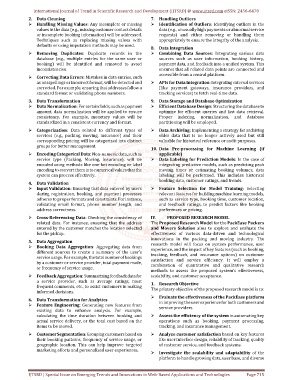Page 725 - Emerging Trends and Innovations in Web-Based Applications and Technologies
P. 725
International Journal of Trend in Scientific Research and Development (IJTSRD) @ www.ijtsrd.com eISSN: 2456-6470
2. Data Cleaning 7. Handling Outliers
Handling Missing Values: Any incomplete or missing Identification of Outliers: Identifying outliers in the
values in the data (e.g., missing customer contact details data (e.g., unusually high payments or abnormal service
or incomplete booking information) will be addressed. requests) and either removing or handling them
Techniques such as replacing missing values with appropriately to ensure the integrity of the analysis.
defaults or using imputation methods may be used.
8. Data Integration
Removing Duplicates: Duplicate records in the Combining Data Sources: Integrating various data
database (e.g., multiple entries for the same user or sources such as user information, booking history,
booking) will be identified and removed to avoid payment data, and feedback into a unified system. This
inconsistencies. ensures that all related data points are connected and
accessible from a central platform.
Correcting Data Errors: Mistakes in data entries, such
as misspellings or incorrect format, will be detected and APIs for Data Integration: Integrating external services
corrected. For example, ensuring that addresses follow a (like payment gateways, insurance providers, and
standard format or validating phone numbers. tracking services) to fetch real-time data.
3. Data Transformation 9. Data Storage and Database Optimization
Data Normalization: For certain fields, such as payment Efficient Database Design: Structuring the database to
amount, data normalization will be applied to ensure optimize for efficient queries and fast data retrieval.
consistency. For example, monetary values will be Proper indexing, normalization, and database
standardized in a consistent currency and format. partitioning will be employed.
Categorization: Data related to different types of Data Archiving: Implementing a strategy for archiving
services (e.g., packing, moving, insurance) and their older data that is no longer actively used but still
corresponding pricing will be categorized into distinct valuable for historical reference or audit purposes.
groups for better management.
10. Data Pre-processing for Machine Learning (if
Encoding Categorical Data: Non-numeric data, such as applicable)
service type (Packing, Moving, Insurance), will be Data Labeling for Prediction Models: In the case of
encoded using methods like one-hot encoding or label integrating predictive models, such as predicting peak
encoding to convert them into numerical values that the moving times or estimating booking volumes, data
system can process effectively. labeling will be performed. This includes historical
booking data, customer ratings, and trends.
4. Data Validation
Input Validation: Ensuring that data entered by users Feature Selection for Model Training: Selecting
during registration, booking, and payment processes relevant features for building machine learning models,
adheres to proper formats and constraints. For instance, such as service type, booking time, customer location,
validating email format, phone number length, and and feedback ratings, to predict factors like booking
address correctness. preferences or pricing.
Cross-Referencing Data: Checking the consistency of IV. PROPOSED RESEARCH MODEL
related data. For instance, ensuring that the address The Proposed Research Model for the PackEase Packers
entered by the customer matches the location selected and Movers Solution aims to explore and evaluate the
for the pickup. effectiveness of various data-driven and technological
innovations in the packing and moving industry. The
5. Data Aggregation
research model will focus on system performance, user
Booking Data Aggregation: Aggregating data from
experience, and the impact of key features (such as booking,
different sources to create a summary of the user's
tracking, feedback, and insurance options) on customer
service usage. For example, the total number of bookings
satisfaction and service efficiency. It will employ a
by a customer or service provider, total payment made,
combination of quantitative and qualitative research
or frequency of service usage.
methods to assess the proposed system’s effectiveness,
Feedback Aggregation: Summarizing feedback data for scalability, and customer acceptance.
a service provider, such as average ratings, most
1. Research Objective
frequent comments, etc., to assist customers in making
The primary objective of the proposed research model is to:
informed decisions.
Evaluate the effectiveness of the PackEase platform
6. Data Transformation for Analytics in improving the user experience for both customers and
Feature Engineering: Generating new features from service providers.
existing data to enhance analysis. For example,
calculating the time duration between booking and Assess the efficiency of the system in automating key
actual service delivery, or the total cost based on the operations such as booking, payment processing,
items to be moved. tracking, and insurance management.
Customer Segmentation: Grouping customers based on Analyze customer satisfaction based on key features
their booking patterns, frequency of service usage, or like user interface design, reliability of tracking, quality
geographic location. This can help improve targeted of customer service, and feedback systems.
marketing efforts and personalized user experiences.
Investigate the scalability and adaptability of the
platform to handle growing data, user base, and diverse
IJTSRD | Special Issue on Emerging Trends and Innovations in Web-Based Applications and Technologies Page 715

